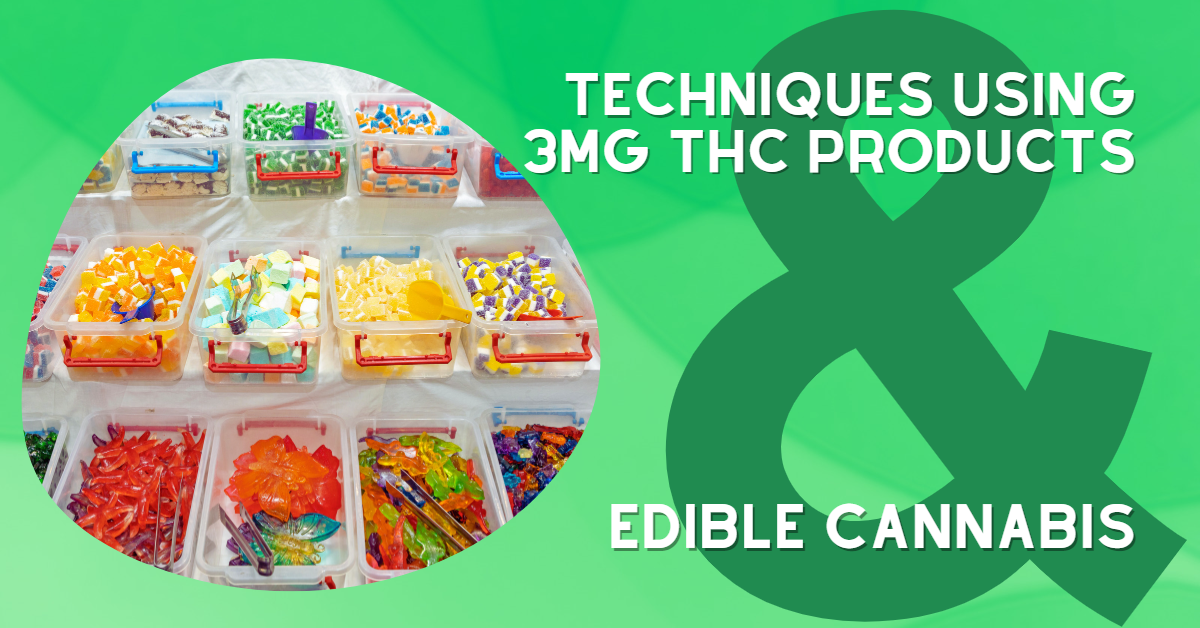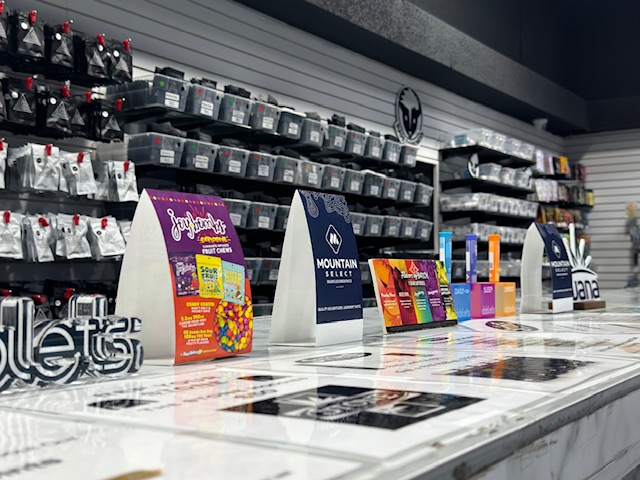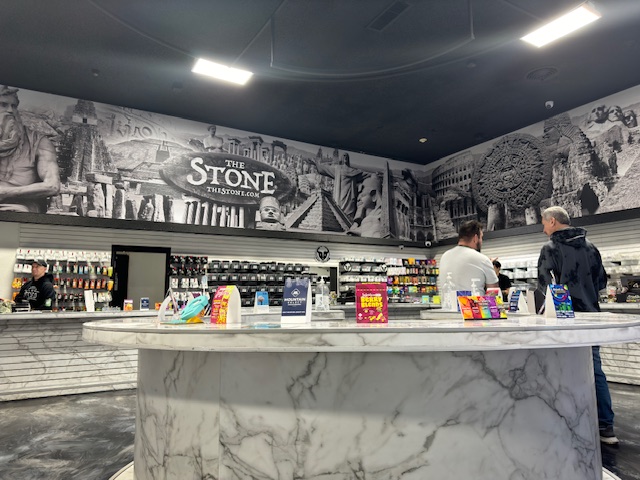
This website is for users aged 21 and over. Please confirm your age.

With the legalization of cannabis worldwide, it’s essential to understand the different types of THC products and consumption methods available to consumers. We will explore the various THC products, including edibles and cannabis products, and how they can be consumed. By gaining a deeper understanding of these advanced techniques using 3mg THC products, such as combining with other edibles or cannabis products, consumers can make more informed decisions and enjoy the benefits of THC products safely and effectively.
THC products are an array of cannabis items containing delta-9-tetrahydrocannabinol (THC). This is the compound responsible for the psychoactive effects of cannabis. There are various types with unique methods of delivery and potency levels.
Flowers or bud is a common form. It is unprocessed cannabis plant material that can be smoked or used for edibles and concentrates. Concentrates are made from cannabis plant material with high levels of THC. They come in wax, shatter, oil, and dab forms.
Edibles are food infused with THC or other cannabinoids. Common types are gummies, chocolate bars, drinks, and baked goods. Tinctures are liquid extracts with THC that add to food or beverages or dropped under the tongue.
Capsules are pills containing THC oil extracts for easy and discreet consumption. Topicals are cannabis-infused creams, balms, and lotions applied to the skin for relief without affecting mental functioning.
The extraction process of THC products affects potency and purity. Butane extraction produces potent concentrates but may have trace amounts of harmful chemicals without proper purification. The Rosin pressing method uses heat and pressure to extract the resin, sometimes resulting in lower potency but a cleaner product without contaminants.
There is an option out there for everyone – except your grandma!
THC products come in many forms. You can smoke dried cannabis flowers or concentrates with pipes, bongs, and dab rigs. Vaporizing is another option that doesn’t involve smoke. Plus, there are vaporization devices like pens and tabletop units. Edibles such as baked goods, candies, and drinks are also a way to consume THC. Sublingual consumption is using extracts dissolved in alcohol or oil under the tongue. Lastly, topical products like lotions, balms, and patches are applied to the skin.
Different methods have different onset times, duration, and intensity of effects. Combining THC products with other edibles or cannabis products containing high levels of THC or other cannabinoids like CBD can amplify the impact. This can lead to over-intoxication and unpleasant side effects. It’s essential to consider dosage and be aware of these risks.
It’s crucial to understand THC products’ therapeutic uses and harmful effects. Studies have highlighted the benefits of cannabinoids for medical conditions such as anxiety, PTSD, and chronic pain. Before combining THC products, check Health Canada’s document on cannabis and cannabinoids for medical purposes. Anyone mixing THC products must consider the process like a science experiment but do it responsibly.
If you want to elevate your cannabis experience, combining 3mg THC products with other edibles or cannabis products is a great option. However, this practice has risks and benefits, so it’s crucial to be informed before you try it out. This section will explore the potential risks and benefits of combining THC products and how to maximize essentials properly.
Combining THC Products can have both potential risks and benefits. Combining two or more THC-containing products may lead to heightened psychoactive sensations for some. But, it can also cause unpredictable results due to varying tolerance levels, like panic attacks, paranoia, or anxiety.
On the other hand, combined THC products could also give robust and fast relief for chronic pain and medical conditions.
Research on combining THC is limited. The dosage depends on factors like sex, age, and consumption habits. So, start with small doses and monitor your tolerance.
Remember, the ingredients in edibles can vary. Be aware of any adverse reactions or changes in behavior.
Properly combining THC products is like creating a perfect playlist. Timing, dosage, and personal preferences are critical. Start small and increase dosage cautiously. With care, combining THC can have both risks and benefits.
Combining THC products can enhance the cannabis experience and synergistic benefits. But, it must be done correctly. Research shows combining different types and methods of consumption can bring better results. However, using any combination of THC without knowing how could cause harm.
When starting, use small amounts of each product before combining. Know your tolerance level, and stick to tested products. Select strains that complement each other based on the desired effect. Allow plenty of time for each method or product’s effect to wear off before starting the next one. Keep track of dosage and consumption methods.
Everyone reacts differently to THC and cannabis products, so begin cautiously. Consult a healthcare professional if there are any questions or concerns. Don’t mix alcohol and THC products, which may worsen memory impairment. Avoid combustion methods, such as smoking. Edibles with vape/tinctures are a safer combination option.
Exploring the highs and lows of THC and cannabis can have therapeutic benefits. But, potential risks should always be kept in mind. Combining usage and knowledge of THC products can enhance the experience and give the desired outcome.
Regarding 3mg THC and cannabis use, there are essential factors to consider. In this section, we’ll explore the potential therapeutic techniques of using 3mg THC products like edibles and cannabis, as well as the potentially harmful effects they can have. We will look at the evidence provided by clinical studies, the role of the CB1 receptor in cannabis use, and limited evidence on certain cannabinoids.
Clinical studies have proved the medical benefits of THC and other cannabinoids. These studies show that THC can help with chronic pain, muscle spasms, and nausea and vomiting caused by chemotherapy. Preclinical research also suggests that THC may help with anxiety and sleep problems.
Recently, more has been learned about the endocannabinoid system (ECS). This system is connected to many body functions and is triggered by cannabinoids like THC. This research explains how THC might work and has uncovered new possibilities for future drug development.
However, THC use has some risks. It can affect thinking and memory and lead to addiction. So, it’s vital to consider THC products’ pros and cons.
Health Canada created “Cannabis and Cannabinoids for Medical Purposes” to advise healthcare providers on prescribing cannabis or cannabinoids as medicine.
If the CB1 receptor could rate cannabis on Yelp, it would be five stars and a thumbs-up!
The CB1 receptor plays a significant role in the psychoactive effects of THC, which is found in cannabis. When THC enters the bloodstream, it binds to CB1 receptors in the brain, causing euphoria, relaxation, and altered perception.
Cellular beta-arrestin two protein activities are stretched at the CB1 receptor site when THC is consumed. This leads to the “high” effect. But, long-term cannabis use can reduce CB1 receptor density, making users tolerant to its psychoactive effects and increasing their risk of drug dependence. Additionally, this adaptation has been linked to mental issues such as anxiety and depression.
Researchers are exploring the possible therapeutic benefits of THC, which targets the altered activity of the system involving CB1 receptors. The techniques using 3mg THC products like edibles and other cannabis products should well advance its exploration. This system is linked to several significant illnesses and conditions. Studies suggest that cannabinoids have pain-relieving properties, effective against neuropathic pain conditions, and can reduce inflammation related to diseases like multiple sclerosis.
Patients should know the potential drawbacks of using THC products, especially with long-term or high-dose use. Understanding how THC works through CB1 receptors is vital to develop plans that prevent adverse outcomes caused by prolonged THC usage.
Cannabinoids, compounds found in cannabis plants, have been studied for years. Some have been researched extensively but not all. This shows the importance of further research on cannabinoids.
THC is a well-known cannabinoid. It is the main one in cannabis and has been studied for its effects on the body and mind. CBD is also gaining attention for its potential to treat conditions such as epilepsy, anxiety, and chronic pain.
CBG and CBN are other cannabinoids that may help with glaucoma and inflammation. However, further research is needed to understand their effects.
Health Canada’s document on cannabis provides info about the benefits and risks associated with cannabinoids. It’s like a doctor’s note in this area with limited evidence.
If you want to explore the benefits of using 3mg THC products for medical purposes, Health Canada’s document on cannabis and cannabinoids is a great place to start. In this section, we’ll discuss how you can access this valuable document to learn more about the medical applications of cannabis and the proper regulations surrounding its use.
Accessing Health Canada’s Cannabis and Cannabinoids Document is possible in various ways. It is for medical purposes and provides info on using cannabis products, including THC, to treat conditions. Visitors can find their website or other online resources for the latest updates and authorized strains.
For a more comprehensive understanding, other online resources explain what people can expect if using cannabinoids for medical reasons. These sources explain how cannabinoids work in the body and list potential therapeutic uses and adverse effects.
It is best to consult a healthcare provider before beginning a cannabis treatment. They can provide advice on dosage, drug interactions, and more, to help make decisions about using cannabis products.
The block may be temporary due to possible misuse or abuse of the site, such as through inefficient use of E-utilities or running a script that overloads the system. Contact the system administrator at info@ncbi.nlm.nih.gov to restore access.
The CB1 receptor is a protein part of the endocannabinoid system. And this concerns various physiological processes such as appetite, pain sensation, and mood. 3mg THC products interact with the CB1 receptor, which can produce euphoric or psychoactive effects.
Evidence from clinical studies suggests that using 3mg THC products may have potential therapeutic services for conditions such as chronic pain and chemotherapy-induced nausea and vomiting. However, there needs to be more research to understand the risks and benefits better. They must also be clinical evidence for techniques using 3mg THC products like edibles and other cannabis products for therapeutic medical conditions.
It is not the recommendation to combine 3mg THC products with other edibles or cannabis products, as this can increase the risk of adverse effects and potentially dangerous interactions.
Cannabis is not an approved therapeutic product unless a specific cannabis product has been issued a drug identification number (DIN) and a notice of compliance (NOC). This is because cannabis must undergo the same rigorous testing and clinical trials as approved medications. And there is not enough evidence of its safety and effectiveness.
The provision of information on the use of cannabis and cannabinoids for medical purposes by Health Canada is not a full endorsement. It is essential to consult with a healthcare professional and consider other reliable sources of information before using cannabis or cannabinoids for medical purposes. This recommendation also covers techniques using 3mg THC products like edibles and other cannabis products.
We warmly welcome you to explore our highly acclaimed strains, concentrates, and edibles. Serving recreational clients with pride is our passion.
At our dispensary, you'll find a professional yet inviting atmosphere that prioritizes your comfort and privacy. Feel free to stop by at your earliest convenience to experience it for yourself. We can't wait to serve you!


